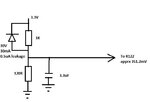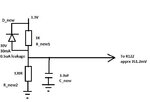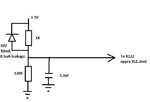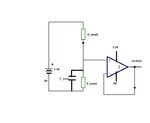eengr
Member level 4
Hi all
I am using an instrumentation amplifier circuit to measure current on my jig.
Instrumentation amplifier has GAIN of 2. (See image below)
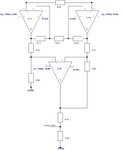
Voltage diver (R124 & R125) at the output divides amplifier’s output by 2 so that Signal at ‘Current_sense’ is same as the voltage drop across 1R resistor hence same as current (ohms law V/R, R=1)
Current_Sense is connected to the input of a buffer (via MUX) and then to 24bit ADC (see the buffer & ADC circuit below)

The circuit is used to measure current. At 1V Rail voltage and No load connected, R116 (sense resistor) has 0V drop across it BUT opamp-IC106 has apprx 9ish mV and then apprx 5mV at Current_sense.
When I connect a load so that R116 (sense resistor) has apprx 18mA, (Node with IC104 is more positive than Node with IC105 to show the load end) the Signal at Current_sens reads 18mA as well
So, it has an offset with No load condition but that is NOT reflected when there is a load connected.
I was wondering if someone could help me to understand what exactly is going on here and why I am getting offset with No load at input. Why this offset is not there when there is Load e.g., at 18mA and if there is a way to fix it so that I get ZERO at Current_Sense when No load is attached at input. Someone suggested to add an external diode at output of IC106 in the feedback path i.e., between pin 1 of IC106 and Node connecting R124 & R123 but not sure how that would help (as I tried it and with existing component values, it did Not work?
BOM is:
I am using an instrumentation amplifier circuit to measure current on my jig.
Instrumentation amplifier has GAIN of 2. (See image below)

Voltage diver (R124 & R125) at the output divides amplifier’s output by 2 so that Signal at ‘Current_sense’ is same as the voltage drop across 1R resistor hence same as current (ohms law V/R, R=1)
Current_Sense is connected to the input of a buffer (via MUX) and then to 24bit ADC (see the buffer & ADC circuit below)

The circuit is used to measure current. At 1V Rail voltage and No load connected, R116 (sense resistor) has 0V drop across it BUT opamp-IC106 has apprx 9ish mV and then apprx 5mV at Current_sense.
When I connect a load so that R116 (sense resistor) has apprx 18mA, (Node with IC104 is more positive than Node with IC105 to show the load end) the Signal at Current_sens reads 18mA as well
So, it has an offset with No load condition but that is NOT reflected when there is a load connected.
I was wondering if someone could help me to understand what exactly is going on here and why I am getting offset with No load at input. Why this offset is not there when there is Load e.g., at 18mA and if there is a way to fix it so that I get ZERO at Current_Sense when No load is attached at input. Someone suggested to add an external diode at output of IC106 in the feedback path i.e., between pin 1 of IC106 and Node connecting R124 & R123 but not sure how that would help (as I tried it and with existing component values, it did Not work?
BOM is:
IC104, IC105, IC106 = OPA140 (from TI)
R116 =1R (1%) / 2512
R117 = R119 = R120 = R121 = R122 = R123 = 10K (0.1%) – 0603
R118 = 20K
R124 = R125 = 100K
Jig_Filtered_Supply = 9V
R280 = 1.5K
R281 = Not fitted
C207 = 1nF
D204 = D207 = 0.5uA leakage Schottkey Diode (Farnell-1459171)
IC215 = LTC2485 (24bit ADC)

